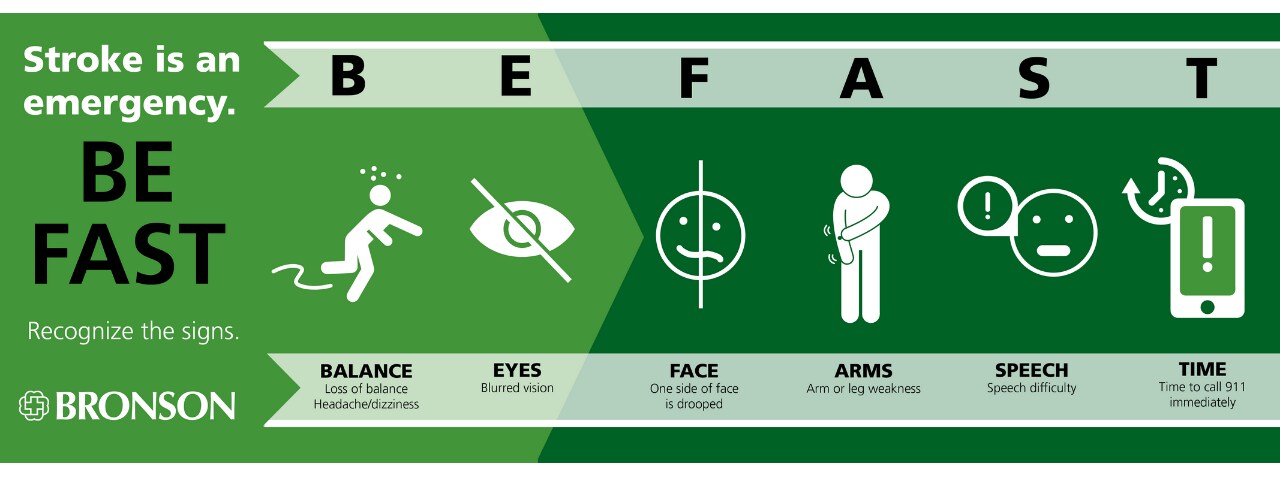Spotting Symptoms of a Stroke
A health article by Dr. Lindsay Bliss, a vascular neurologist at the Bronson Neuroscience Center.
Spotting the early symptoms of a stroke is vital to survival and recovery. Do you know what to look for?
It can be easy to mistake stroke symptoms for other common ailments. Arm weakness might be mistaken for a muscle tweak. A headache, dizziness, or weakness might be mistaken for simply being tired. Failure to react to the warning signs of a stroke can lead to a more severe outcome. This is one of the reasons why stroke is the fifth leading cause of death in the United States and the leading cause of adult disability.
The key to achieving the best possible outcome for a person having a stroke is to know the signs and BE FAST.
Many times, people who are having a stroke wait too long before getting help. There is a crucial four-and-a-half-hour window that is vital for a patient to have the best chance of recovery.
Ischemic stroke is the most common.
This is when a blood clot blocks a blood vessel in the brain. To reverse the symptoms of these strokes, staff in the emergency department administer a clot-busting medication known as a tissue plasminogen activator (tPA) if the patient is eligible.
The faster we can give tPA to an ischemic stroke patient, the better the outcomes for patients. You need to call 911 as soon as symptoms start or have someone take you to the nearest emergency department. If you can do this, you greatly reduce the chance of disability from stroke.
Transient ischemic attack (TIA), also called a “mini-stroke.”
Like an ischemic stroke, it causes blockage in a blood vessel in the brain. Unlike an ischemic stroke, a TIA often resolves in minutes. Because of this many people ignore the symptoms as they start to feel better.
It’s important to seek emergency care if you think you are having or have previously had a TIA. Many times, a TIA is a warning sign of a more serious stroke to come. Your doctor will work with you to create a plan of care to lower your chance of a more serious stroke in the future.
Hemorrhagic stroke is the most serious.
This type of stroke is often caused by uncontrolled high blood pressure. The pressure puts stress on the brain’s blood vessels causing them to weaken and rupture. Once bleeding occurs, the brain is not able to function properly.
Sometimes a hemorrhagic stroke can be treated with medications that control blood pressure and reduce brain swelling. Depending on the size of the bleed, surgery may need to be performed.
Although most strokes happen to older adults, young people are also at risk. Ten percent of stroke victims in the United States are under 45.
Some risk factors in young adults include:
- smoking
- binge drinking
- diabetes
- high blood pressure and cholesterol
These risk factors also apply to older adults, with an emphasis on high blood pressure as the main cause of stroke.

Strokes can be treated across the entire Bronson system. No matter which Bronson hospital someone chooses, emergency teams are prepared to diagnose a stroke and begin immediate treatment to reduce the severity of a stroke and improve recovery. If needed, Bronson Battle Creek, LakeView and South Haven will transfer stroke patients needing advanced care to the Comprehensive Stroke Center at Bronson Methodist Hospital.
Meet the Author
Dr. Lindsay Bliss is a vascular neurologist at the Bronson Neuroscience Center in Kalamazoo and Battle Creek. Patients who come to any Bronson hospital after suffering a stroke will find a wide range of treatments and services. The stroke team, including vascular neurology, neuroendovascular surgery, neuro intensive care, neurosurgery and emergency care providers all work together to deliver immediate, life-saving care.
For more information on stroke care at Bronson visit bronsonhealth.com/stroke.

Meet the Author
Dr. Lindsay Bliss is a vascular neurologist at the Bronson Neuroscience Center in Kalamazoo and Battle Creek.
Discover Her Approach to Care

Health News From Bronson's Experts
Check out the latest news at Bronson and health-related articles from our healthcare experts.
Read Articles